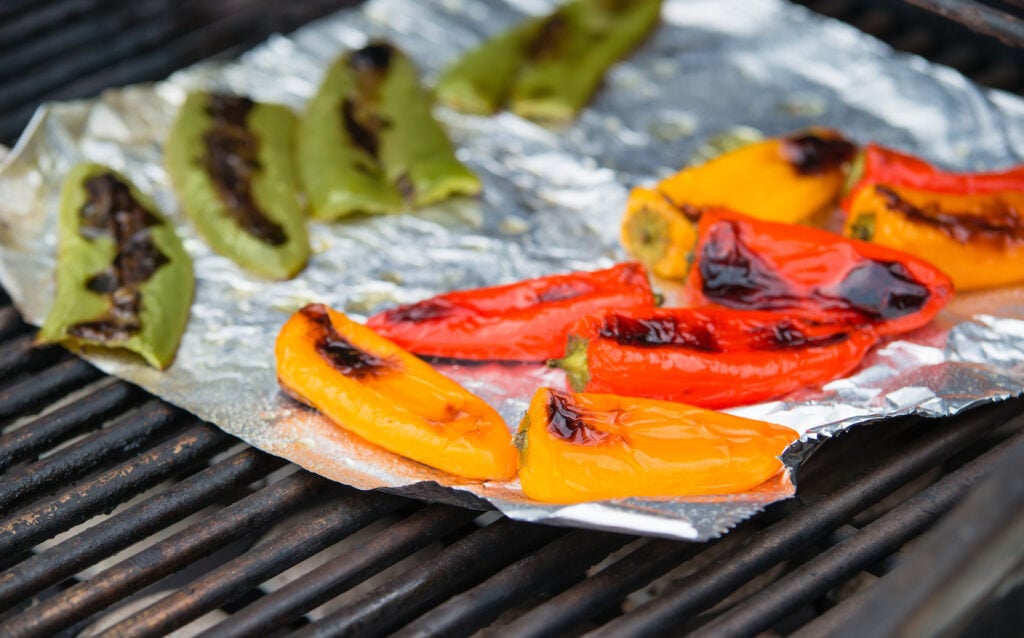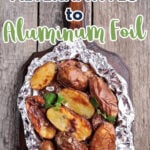9 Safe Alternatives to Aluminum Foil
Aluminum foil has been a useful item for cooking and storing food for decades. It’s a staple in most kitchens and has become a go-to item for many home cooks. However, its usefulness in the kitchen doesn’t outweigh the harm it can do – something many people have never considered.
Here’s how aluminum foil contributes to environmental and bodily damage. You’ll also find aluminum foil alternatives to make your kitchen more eco-friendly.

Why Is Aluminum Foil Bad?
If you grew up helping around the kitchen, you might be surprised to learn that there are health and safety issues with tin foil and other kitchen items like plastic wraps. The problem is two-fold: causing both health and environmental challenges.
Aluminum’s Effects on Health
There is lingering concern about using aluminum foil for cooking. Although it’s considered safe for packaging, foods cooked in aluminum are exposed to the metal, which can seep in at high temperatures. As a result, the food can have higher aluminum levels than the amount recommended by the World Health Organization (source).
High concentrations of aluminum have also been detected in the brain tissue of patients with Alzheimer’s disease. (source) Studies suggest that high aluminum intake may be harmful to some patients with bone diseases or renal impairment. (source) Aluminum can build up in the bones, taking the place of calcium. Too much aluminum in bones will show up as high levels of calcium in the blood which can lead to osteoporosis.
Heavy exposure can even lead to behavioral and neurological changes in humans. (source) It also reduces the growth rate of human brain cells. (source)
Although aluminum is generally considered safe for storing foods, acidic foods are the exception to this rule. The acid from citrus and tomatoes can leach aluminum into your food. So it’s best to use one of these alternatives for both cooking and storing fruits or vegetables with a higher acid content.
Aluminum’s Effects on the Environment
Aluminum foil can damage the environment at multiple points in its life cycle. First, the aluminum industry accounts for about 2.5% of global CO2 emissions. That number is not too staggering, but most of it occurs during the refining process, which requires high amounts of electricity (source). This depletes nonrenewable energy sources and increases the energy demand.
Aluminum foil is recyclable, but it needs to be clean and free of food waste. Most people don’t bother cleaning it, and instead throw away used foil. It either ends up in landfills where it takes more than 400 years to decompose, or it gets incinerated and releases toxins into the atmosphere. (source) The refining process does this as well.
Studies have found that exposure to aluminum toxins – namely a bauxite residue called “red mud” – is harmful to plants and animals, damaging vital organs during absorption or inhalation. (source)
The toxins don’t just contaminate the air but the ground as well. Smelting aluminum produces a hazardous product called spent pot lining (SLP), which runs off from landfills and gets into the local soil and waterways. SLP can contain foreign metals, hydroxides, carbides and other compounds that damage the local ecosystem.
Alternatives to Aluminum Foil for Cooking and Baking
An essential part of living a sustainable, fulfilling life is nourishing yourself with fresh, clean foods. Aluminum foil is just one modern product that gets in the way of being healthy. Here are some better alternatives to cooking with aluminum foil and food storage that contain fewer corrosive chemicals and have longer life cycles.
These options work for both food storage and cooking.
Glass
Glass is one of the best alternatives to aluminum foil for cooking, baking, and storage. It might be more delicate and less malleable than foil. But it’s also odorless, has no harmful chemicals, and provides infinite uses while remaining intact.
You can use any type of glass containers for storage, but you need to use tempered or borosilicate glass for cooking. Tempered glass undergoes an intense heat-treating process during production, while borosilicate glass contains the durable compounds boron trioxide and silica. Both types are stronger and more heat-resistant than the average glassware.
Mason jars have endless uses in the kitchen. You can store food and many pantry items in them. They also work in the freezer.
There’s no room for misinterpretation about recycling glass, either. While some people have no idea aluminum is recyclable, everyone is on the same page about glass. Glass is the clear winner over aluminum throughout its long life cycle.
Stainless Steel
Stainless steel shares all of glass’s qualities and then some: odorless, no chemicals, heat-resistant, and nearly unbreakable. Additionally, while glass only comes in container shapes, stainless steel takes many shapes and forms.
You can find utensils, pots, pans, baskets, sheets, and trays made from stainless steel. This is important because many types of cookware contain aluminum. Aluminum leaches into foods when cooking at high heat.
This material contains many strong and valuable alloys, including iron, nickel, molybdenum and chromium for the shiny finish. It also has an eco-friendly life cycle.
When stainless steel is recycled and melted down, the alloys remain intact and are reused in another product. It can also be recycled many times over. In fact, an estimated 56% of stainless steel products come from recycled materials. (source)
For food storage, opt for stainless steel containers. You can find them with stainless locking lids or silicone lids, which are great for storing leftovers. And for taking food on the go, you can pack it in bento style lunchboxes.
Silicone
You can find baking sheets, cutting boards, trays, bowls, cupcake wrappers, lids and many other kitchen items made of silicone. It’s a durable, heat-resistant material and is as reliable as they come. Most kitchen items in this category are made from food-grade silicone, but it’s worthwhile to double check to make sure.
A silicone mat reduces the need for single use items like foil or parchment paper for lining baking sheets. It’s reusable and easy to clean.
When baking or cooking with silicone, avoid extremely high temperatures (480 degrees Fahrenheit +) due to low levels of chemicals that can released with high heat.
Although it’s a more sustainable option than plastic, it’s difficult to recycle, and most plants won’t accept the material. It also uses hydrocarbons from petroleum, which contributes to fossil fuel consumption. Still, it’s more sustainable than aluminum, and that’s what counts.
Cedar Wood
For all of glass and stainless steel’s redeeming qualities, the initial manufacturing process consumes a lot of energy because they’re complex materials. Cedar wraps have become popular cooking items in recent years, and not just because of their eco-friendly nature.
They also offer convenience and flavor. You just need to soak the wraps in water, wrap them around your food and put them in the oven, grill, or air fryer. They add a rich, smoky flavor to the food, which makes them particularly effective for grilling.
When you’re finished using cedar wraps, throw them on the compost pile, use them as fire starters, or just toss them into the woods. They’re 100% biodegradable.
Seaweed
Seaweed is another foil alternative with mainly natural ingredients. The main piece of the puzzle is Ooho, an edible, biodegradable membrane made from seaweed extract. It doesn’t have any natural flavors, so you don’t have to worry about changing your food taste. Just dampen it, wrap it around your favorite food, and cook as you normally would.
You can also use seaweed wraps for storing food, but don’t hold onto them for long. Even though they’re treated to avoid rapid decomposition, they can still develop a bad smell. Try to reserve your seaweed wraps for seafood items with a similar odor.
Food Storage Alternatives to Aluminum Foil
Aluminum foil can be safe and sustainable, but only if you use it for storage and recycle it properly. Using or discarding it the wrong way can harm humans and the environment. These natural products are suitable for storing (not cooking) food.
Beeswax
Beeswax wraps are also sustainable substitutes like cedar wraps, but they have two distinct advantages: reusability and versatility. Their main ingredient is organic cotton infused with food-grade beeswax, coconut oil and tree resin, which makes for a malleable material that can cover any food item you want. It doesn’t rot over time and can withstand high temperatures.
Beeswax food wraps also come in customizable sizes and designs. Each one is generally good for six to 12 months before it starts deteriorating. To clean it, gently rinse with dish soap and cold water and let it air dry. The colors and designs might fade with each wash, but the flexibility will remain consistent.
Cloth
Cloth is another great option for an eco-friendly, reusable food cover. Take your cloth or muslin bags to the farmer’s market or grocery store and then place your veggies right in the fridge.
Swedish dish cloths or tea towels also work for covering food. Line your crisper drawer with cloth to help absorb moisture and make foods last longer.
Cloth and fabric covers will hold up for food storage for years. When you consider the amount of foil you would’ve used during that time, fabric is one of the most sustainable materials on the list.
Organic Plant-Based Food Wraps
Vegetarian and vegan readers have their ideal alternatives to aluminum foil with organic plant-based wraps. Unlike the seaweed and beeswax products which include some artificial ingredients, organic wraps are 100% natural, made from the waxes, oils and resins of different plants.
FAQ’s About Aluminum Foil Alternatives
Beeswax wraps are some of the best eco-friendly alternatives. Because they are so malleable, you can use them to cover almost any dish or container… including bowls that don’t have a lid. They’re also perfect for wrapping sandwiches and loose foods.
This is where a baking stone, stainless cookie sheet, or reusable silicone baking mat can be super useful. Cookie dough can go directly on a baking stone or a stainless cookie baking sheet. Or you can use a silicone baking mat as a liner for perfectly baked cookies and treats.
Wax paper or unbleached parchment paper are also options, but your best bet for the planet is always reusable.
Yes! And they’re actually better. “Wrapping the potatoes in foil actually steams them instead of baking them, explains Emily Walker of Favorite Family Recipes. “This is because it traps all the moisture inside. You will end up with a soft skin and the inside just won’t be as fluffy.”
Instead rub oil and salt on the outside of the potatoes and place them directly on the oven rack for a crispy outside. Be sure to place a baking pan on the rack below the potatoes to catch any drippings.
Cleaner Kitchen, Cleaner Body, Cleaner Life
Diet is a crucial part of a healthy lifestyle, but we can’t have effective diets if we don’t use the right kitchen tools. Although it’s cheap and convenient, aluminum foil is holding back your wellness journey. It contaminates cooked food and releases harmful toxins into the environment after you throw it away.
Thankfully, there are other things you can use that are just as good and are much better for the planet and your health.

